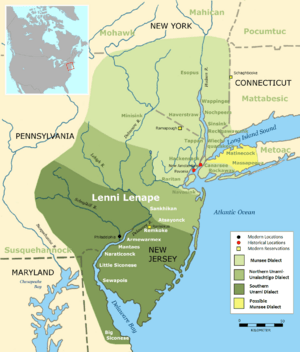Esopus people facts for kids

Map of Lenape lands and tribes showing the Esopus people living in the northern part of the territory west of the Hudson river
|
|
| Total population | |
|---|---|
| unknown, descendants are part of the Stockbridge-Munsee Community | |
| Regions with significant populations | |
| Wisconsin, formerly Upstate New York | |
| Related ethnic groups | |
| other Lenape people |
The Esopus tribe (pronounced es-SOAP-es) was a group of Lenape (Delaware) Native Americans. They lived in the Catskill Mountains area of what is now Upstate New York. Their lands included parts of modern-day Ulster and Sullivan counties.
The Lenape people originally lived in the Delaware River Valley. Their territory later grew to include parts of New York, Pennsylvania, New Jersey, and Delaware. In the year 1600, there were an estimated 10,000 Lenape people. The Esopus people spoke a language called Munsee. It was a dialect of the Algonquin language family.
The Esopus tribe usually lived in small groups of 10 to 100 people. They moved with the seasons, often settling near water sources. They were skilled farmers. Their main crop was corn, but they also grew beans and squash. They gathered nuts and berries. For food, they hunted animals like elk, deer, rabbits, turkey, and fish. They typically ate two meals a day, depending on what food was available.
In their society, the Esopus people had clear rules about who could marry. This helped keep their families strong and healthy. People generally lived to be about 35 to 40 years old. Sachems or chiefs were leaders who made decisions for the good of the tribe. Both men and women had important roles in the community. No one gender ruled over the other.
Contents
History of the Esopus People
Early Interactions and Land Sales
The first known meeting between the Esopus people and European colonists happened in 1609. In 1652, the Esopus tribe sold 72 acres of land to colonists. This happened through a land deal with Thomas Chambers in Kingston, New York. It is not clear if the two Esopus chiefs, Kawachhikan and Sowappekat, fully understood the sale. There was a language barrier. Also, their culture had different ideas about money, ownership, and legal agreements. This land deal started a long period where the Esopus people lost their lands. This continued with later land deals, even into the late 1800s.
The Esopus Wars
The Esopus tribe fought a series of battles against settlers from the New Netherland colony. These fights happened between September 1659 and September 1663. They are known as the Esopus Wars. The battles took place in and around Kingston. After these conflicts, the tribe sold large areas of land to French settlers called Huguenots. These settlers founded communities like New Paltz.
The Esopus Wars greatly harmed many Lenape communities in what is now Ulster County. The population of the Esopus people decreased due to fighting with Dutch and French settlers. Many also died from widespread diseases, especially smallpox. Fights with other Native American tribes also caused more deaths.
The Esopus People Today
After the Esopus Wars, many Stockbridge-Munsee people moved to Western New York. They settled near Oneida Lake. However, in the 1800s, they were forced to leave these lands. This happened because of Indian Removal Treaties. By the 1830s, they were made to settle on difficult land in Wisconsin.
Today, many descendants of the Esopus people live on the Stockbridge-Munsee Community reservation. This reservation is in Shawano County, Wisconsin. Some also live among the Munsee Delaware people in Ontario, Canada. Historians believe that some Esopus people joined with the Wappinger people after Kieft's War in 1643.


